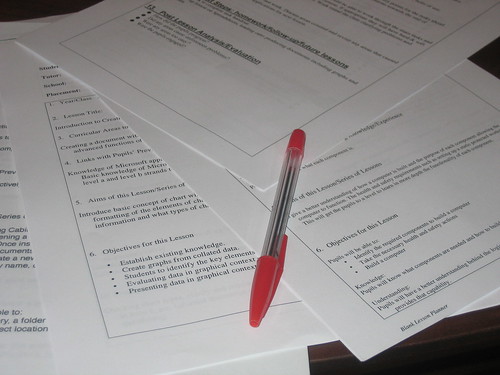By Mary Bigelow
Posted on 2012-02-28
 I’m a new teacher with six classes: four biology and two ecology. The teacher’s manual for my textbooks in these subjects have many interesting lab activities, but I am having difficulty selecting and organizing them. I feel like I live at school! Do you have any suggestions?
I’m a new teacher with six classes: four biology and two ecology. The teacher’s manual for my textbooks in these subjects have many interesting lab activities, but I am having difficulty selecting and organizing them. I feel like I live at school! Do you have any suggestions?
–Tony from Illinois
There’s no way around it—the first year is a challenge for new teachers. You’re dealing with content and curriculum, classroom management, lab management, assessments, technology, and developing your routines and your own style of teaching. But it does get better the second year and beyond.
In terms of choosing which activities to do, consult your school’s curriculum for the learning goals for a given topic. Some curriculum documents also include suggested activities. Then select activities that will help students meet the learning goals (and you’re not limited to the textbook—for example, NSTA’s SciLinks has teacher-oriented websites with activities on hundreds of topics.). Also look for activities that provide opportunities for enrichment and additional exploration.
Make sure the students can do the activity safely in your classroom/lab. I found it helpful to go through a new activity prior to class from a student’s perspective to identify any possible concerns. No matter how interesting it seems, you should not include any activity that cannot be done safely. For those, you could substitute a simulation or video.
In an ideal setting, your classes in each subject would meet back-to-back, with a planning period in between. But most of us who have taught multiple subjects rarely have an ideal setting. Rather than trying to take down and set up activities several times during the day, try to schedule your labs in each subject on different days.
On lab days, it’s helpful to establish routines for students to access and return needed materials. Plastic boxes, trays, or dish tubs can become your best friends for distributing and collecting materials. Have one for each lab group, label it (e.g., Group 1, Group 2), and require each team use the box with their label. Since you have two subjects, it would be helpful to have two sets, each a different color so it’s easy for you and your students to recognize which set is for which subject. Use these containers to organize the materials for an activity—thermometers, glass slides, calculators, handouts, rulers, markers, beakers. Prepare ahead of time so that one student from each group can get the box and they’re ready to go. I also included an index card “inventory” in each box so students knew what was to be returned. Save the cards to use the next time you do the lesson. I also put a summary of safety issues on the card as a reminder of what we discussed prior to the activity.
A few minutes before the end of the period, your routine should include the students referring to the card to organize the materials. Before dismissing the class, you can do a quick inspection to see that everything is in the box and determine if anything should be replenished. You may need to model these routines at first, but once students have internalized them, clean-up is much easier.
If the lab requires any equipment or materials that could be potentially dangerous if they were to leave the room, have the students return it to you in person. (My seventh-graders were very trustworthy, but I still collected any forceps, scissors, or scalpels myself.)
Take a photo of a box that is set up for class and save it with your lesson plan. Add a section at the beginning of your lesson plan in which you list the materials you need. Even if the lesson does not include a lab activity, knowing what you’ll need ahead of time is a timesaver. After the lesson, annotate your plan with any changes you would make.
Store any specialized materials for an activity in a labeled box or plastic bag, ready for the next time you do it. Be sure that any chemicals are returned to their designated places in the storeroom.
Even veteran teachers sometimes feel like they live at school, as they redesign lessons, try out new activities, or update their assessments. Science teachers already work hard; we also need to work smart with thoughtful planning, organization, and reflection.
Photo: http://www.flickr.com/photos/40964293@N07/4018106328/



 I’m a new teacher with six classes: four biology and two ecology. The teacher’s manual for my textbooks in these subjects have many interesting lab activities, but I am having difficulty selecting and organizing them. I feel like I live at school! Do you have any suggestions?
I’m a new teacher with six classes: four biology and two ecology. The teacher’s manual for my textbooks in these subjects have many interesting lab activities, but I am having difficulty selecting and organizing them. I feel like I live at school! Do you have any suggestions?